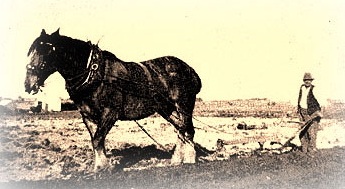
The Welney Website
Ken Goodger's "Farming Diary" July 2011
page created 17th August 2011, amended/updated Saturday, 18 October 2014

|
For several years Ken Goodger wrote a series of excellent articles for our parish magazine,
Welney News, published under the title 'Farming Diary'. This article was posted courtesy of Ken and the then editor of WN. Regretably, posting other diaries have been blocked by the successor editor. |
This article was first published in issue 82 of Welney News
"What a summer we have had so far, extreme dry weather from February through to June and we even had Welney designated an official drought area. Did any eagle-eyed villagers spot the Welney/Tipsend field that featured on the BBC national news.? Yet again weather has dominated the farming scene so far this year, we returned from a late holiday around the 4th March and up until late June we had only received around 25mm rain. The dry spell that started end of February/early March saw much frantic farming activity as planting and drilling conditions were excellent following the hard frosts we had received early winter. Drilling of barley, spring wheat, sugar beet and then the planting of potatoes went ahead in perfect conditions although towards mid April conditions were very dry and those crops drilled into more difficult soil without irrigation would struggle.| If you've visited this page before you may need to "refesh" the page to see the latest version by clicking the browser reload button |

Sugar beet that had been drilled into this type of land also struggled to emerge. On some of the more difficult soils the beet emerged but then failed to grow beyond about the 6 to 8 leaf stage and one could clearly see when driving by fields plants at two or three different growth stages in one field.
Potatoes however did emerge well and grew quite well where crops had been planted late March /early April. These tended to be planted in the better soils, the crops planted more mid April onwards and into the heavier soils were those to emerge with less enthusiasm. We had our last field which was not planted until the last week of April due to waiting for the seed potatoes to arrive, the land had been cultivated and de-cloded ready. This unfortunately allowed the potato ridges to dry in the sun and wind and when we planted about 5 days later, it was very dry and dusty and no moisture left at all, this area only emerged around mid June around 4 to 6 weeks after the rest of the field, a bit worrying when it needs to be the first crop lifted.
With the continuous dry weather during the normal fast growth period during April/May this is when agrochemicals are applied for weed and disease control along with nitrogen fertlisers during rapid growth and yield. Concerns are that nitrogen would not be absorbed by the roots as well due to very dry soil and although nitrogen granules appeared in most cases to dissolve they would not percolate through the dry soil to the active roots where they could be taken up. Weed chemicals have certainly not worked as well where crops have been short and thin which has allowed sun light through the canopy and weeds were stunted by some chemicals but sunlight has caused them to recover and they are now showing through the top of the crop. This could create a difficult harvest unless much glyphsate (roundup) is used beforehand. A few years ago a second weed spray would have been applied to prevent these weeds but we now have tighter control on application of certain chemicals and particularly with regard to harvest interval ( the time between application and harvest of the crop) and growth stage of the crop. Many of the weed sprays can now no longer be applied after the ear has emerged. Fungicides and insecticides have much closer Harvests intervals and in a wet year if you have not applied enough fungicides then your crop can be at risk of mycotoxin infections and risk rejection from the food chain, so double-edged sword for this one.
We are growing 35 acres of malting barley this season and the fat hen weeds were not killed by the weed spray as dry weather made them tougher to absorb the chemical. This has caused them to emerge above the crop in places looking slightly untidy. We will need to be very careful using roundup on malting barley as although it can be used it can prevent the seed from growing and for malting the maltster will require the barley to sprout so again another head scratcher. We need to remove the green weeds if we can as this will raise the moisture and contamination levels in the grain; our other option is to harvest on a really hot day, something we did not achieve last season.

German chamomile harvest has been completed and was some 10 days earlier than other years, the crop again produced less tillers so less flowers so more weeds protruding at harvest. Due to the weed base we may decide to remove these fields to bring about some weed control and return them to wheat before attempting another crop. English chamomile has started this week and will continue till August along with yarrow, hyssop and Melissa. We did yesterday start planting a new crop for us, we are trialling an acre of sage so that will be one to watch.

The dry weather has seen a big influx of aphids particularly into wheat and potato crops and some aphids resistant to the older insecticides are evident causing us to switch insecticides to control these serious pests. Disease pressure has not been too bad although rusts in wheats like hot dry weather and where fungicides were not applied to small missed areas the effect is quite clear, green leaf completely killed.
On the nature front, we have huge large numbers of brown hares on the farm now and I just wonder whether there may have to be some culling this winter as numbers are quite high. Rabbits and pigeons have been the biggest problem this spring, pigeons again eating much rape and even sugar beet. I saw a lot of damage in a beet field only two weeks where pigeons had been grazing. Rabbits are everywhere, something I have never seen before, every yard or old site of buildings seem to be overrun with rabbits and of course crops have suffered with us losing around 2 acres of sugar beet in one location - plenty of rabbit shooting if any one likes rabbit stew!
|
Acknowledgements. Copyright: Text and photos © 2011 Ken Goodger and Welney News Article from Welney News issue 82. |
I can definitely comment we are capable of working with nature
Ken Goodger July 2011